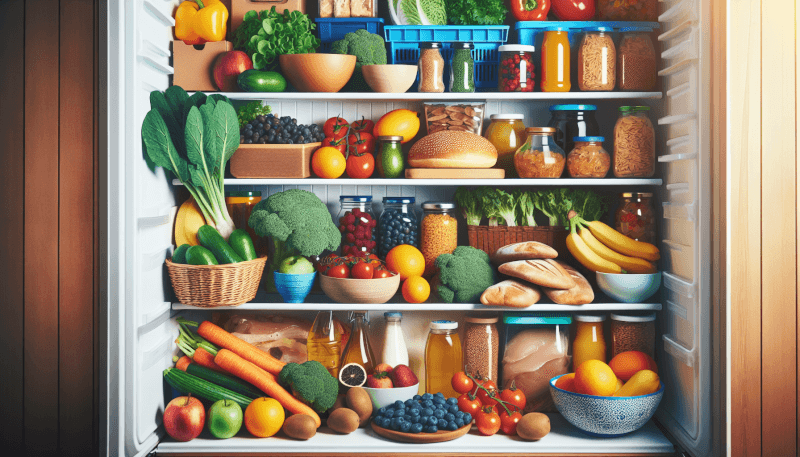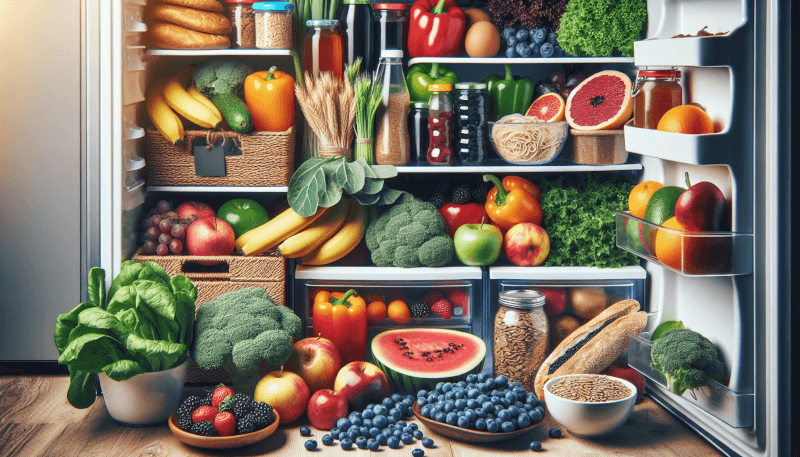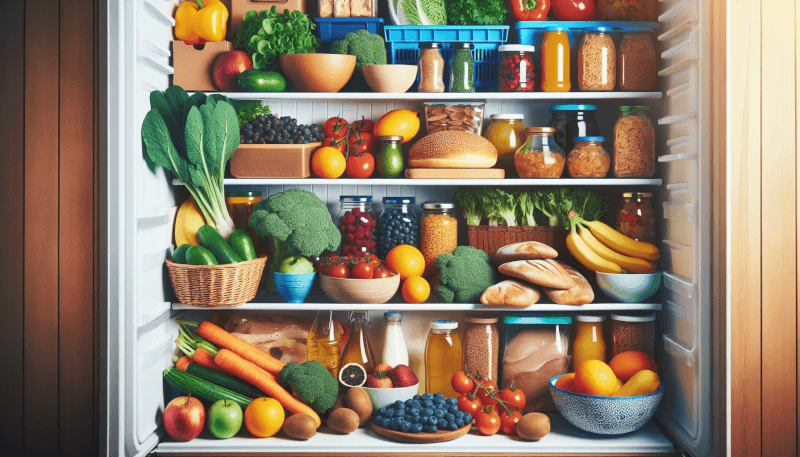In this article, you will discover valuable tips for healthy eating as a diabetic. Living with diabetes can present unique challenges when it comes to food storage. By understanding how to effectively manage and store your food, you can maintain a balanced and nutritious diet that supports your overall health and well-being. From pantry organization to refrigerator essentials, we will explore practical strategies that will make your meal planning and preparation a breeze. Let’s dive in!

Understanding the Diabetic Diet
Living with diabetes requires careful management of your diet to maintain stable blood sugar levels. By understanding the diabetic diet, you can make informed choices about the foods you consume. The key to a healthy diabetic diet lies in balancing carbohydrates, proteins, and fats. This balance helps regulate blood sugar levels and promotes overall wellbeing.
Balancing Carbohydrates, Proteins, and Fats
Carbohydrates are an essential source of energy for the body. However, they can have a significant impact on blood sugar levels. It is important to choose complex carbohydrates that are digested slowly, such as whole grains, legumes, and vegetables. Protein is crucial for maintaining muscle mass and supporting overall health. Opt for lean sources of protein like skinless poultry, fish, tofu, and legumes. Healthy fats, such as avocados and olive oil, can help improve heart health. Always opt for unsaturated fats and limit saturated and trans fats.
Focusing on Low Glycemic Index Foods
The glycemic index (GI) measures how carbohydrates in foods affect blood sugar levels. Foods with a low GI are digested more slowly, resulting in a gradual rise in blood sugar levels. Prioritize low GI foods such as whole grains, legumes, non-starchy vegetables, and most fruits. These foods have a minimal impact on blood sugar levels and can promote stable glucose control.
The Importance of Portion Control
While choosing the right types of food is crucial, portion control is equally important. Overeating, even with healthy foods, can cause spikes in blood sugar levels. Measuring your food portions and using smaller plates can help you maintain a healthy weight and prevent post-meal blood sugar fluctuations. Be mindful of portion sizes, monitor your intake, and avoid consuming excessively large meals.
Designing Your Food Storage
Having a well-organized food storage system is essential for diabetics, as it allows easy access to diabetes-friendly foods. Properly assessing your current food stock, creating a diabetes-friendly grocery list, and organizing your pantry and refrigerator can greatly improve your success in managing your diet.
Assessing Your Current Food Stock
Start by evaluating the items you currently have in your pantry and refrigerator. Check expiration dates and remove any foods that may no longer be safe to consume. Pay close attention to foods high in sugar, unhealthy fats, and refined carbohydrates. Remove these items from your storage to avoid temptation and to make room for healthier options.
Creating a Diabetes-Friendly Grocery List
When creating your grocery list, focus on foods that align with the diabetic diet. Include a variety of whole grains, lean proteins, healthy fats, and fresh fruits and vegetables. Consider purchasing items in bulk, such as whole grains and canned legumes, as they have a longer shelf life and can be cost-effective.
Organizing Your Pantry and Refrigerator
Maintain an organized storage system to make it easier to locate and access the foods you need. Keep items with earlier expiration dates towards the front of your pantry and refrigerator, ensuring they are used and consumed in a timely manner. Use clear storage containers to store perishable items to help prevent waste and maintain freshness.
Stocking Up on Diabetes-Friendly Foods
By stocking up on diabetes-friendly foods, you can ensure that you always have nutritious options readily available. Focus on incorporating whole grains and high-fiber foods, lean proteins, healthy fats and oils, and fresh fruits and vegetables into your food storage.
Whole Grains and High-Fiber Foods
Whole grains, such as quinoa, brown rice, and whole wheat bread, provide essential nutrients and fiber. Fiber slows down the digestion process, preventing sudden spikes in blood sugar levels. Incorporating high-fiber foods like legumes, oats, and berries into your meals can help you feel fuller for longer, regulate your blood sugar, and improve digestion.
Lean Proteins
Lean proteins are an essential component of a healthy diabetic diet. Opt for skinless poultry, fish, tofu, and legumes as they are low in fat and high in nutrients. Protein helps stabilize blood sugar levels, supports muscle growth and repair, and promotes a feeling of fullness after meals.
Healthy Fats and Oils
Include healthy fats and oils in your food storage to support heart health and provide essential fatty acids. Choose sources such as avocados, nuts, seeds, and olive oil. These fats can help improve insulin sensitivity, reduce inflammation, and contribute to a healthy balance of cholesterol in the body.
Fresh Fruits and Vegetables
Fresh produce should be a staple in any diabetic’s food storage. Fruits and vegetables are packed with essential vitamins, minerals, and fiber, making them integral to a well-rounded diet. Opt for a variety of colorful options to maximize nutritional benefits. Consider washing and cutting fruits and vegetables in advance to make healthy snacks and meal preparations more convenient.
Choosing Convenient and Nutritious Packaged Foods
While fresh foods are ideal, it’s essential to have convenient and nutritious packaged foods in your food storage for times when fresh options may not be available. By understanding how to read food labels, identify hidden sugars and carbohydrates, and find low sodium and low-fat options, you can make informed choices.
Reading Food Labels
When purchasing packaged foods, read the food labels carefully. Pay attention to serving sizes, total carbohydrate content, and added sugars. Look for foods that are low in added sugars, saturated fats, and sodium.
Identifying Hidden Sugars and Carbohydrates
Many packaged foods contain hidden sugars and carbohydrates that can raise blood sugar levels. Ingredients like dextrose, fructose, and corn syrup are common culprits. Choose foods with minimal added sugars and opt for whole foods instead of those with processed or refined ingredients.
Finding Low Sodium and Low-Fat Options
Diabetics are at an increased risk of heart disease, so it’s important to prioritize foods that are low in sodium and unhealthy fats. Look for low-sodium versions of canned goods, choose lean cuts of meat, and opt for reduced-fat or fat-free dairy products. Prioritize cooking methods that involve grilling, baking, or steaming rather than frying.

Optimizing Food Preservation Techniques for Diabetics
Properly preserving food can help maintain its quality and extend its shelf life. By exploring techniques such as freezing and storing fresh produce, canning and preserving homemade meals, and utilizing vacuum sealing, you can optimize your food storage and reduce waste.
Freezing and Storing Fresh Produce
Fresh produce can be frozen to preserve its nutritional value. Wash and cut fruits and vegetables into appropriate sizes for later use. Arrange them on baking sheets and freeze individually before transferring to freezer-safe bags or containers. Properly sealed and labeled containers help maintain freshness and maximize the lifespan of your fruits and vegetables.
Canning and Preserving Homemade Meals
Canning and preserving homemade meals can provide convenience and variety in your food storage. Invest in canning equipment and follow safe canning practices to ensure food safety. Store homemade soups, stews, and sauces in glass jars or cans for long-term preservation.
Utilizing Vacuum Sealing for Longer Shelf Life
Vacuum sealing removes air from packaging, which helps maintain the quality and extend the shelf life of various foods. Use a vacuum sealer to package dry goods like grains, nuts, and seeds. Additionally, consider vacuum sealing individual portions of meals for easy reheating and portion control.
Meal Planning and Preparing Ahead
Meal planning and preparing ahead can save time and ensure that you have healthy, diabetes-friendly meals readily available. By utilizing techniques such as batch cooking and portioning, freezing diabetic-friendly meals, and creating meal kits, you can simplify your daily meal preparation.
Batch Cooking and Portioning
Batch cooking involves preparing larger quantities of meals and portioning them into individual servings. This method allows you to control portion sizes and have pre-prepared meals throughout the week. Invest in meal prep containers to easily store and reheat your batch-cooked meals.
Freezing Diabetic-Friendly Meals
Freezing meals is a convenient way to have nutritious options available when you need them. Prepare and cook your favorite diabetic-friendly dishes, portion them into individual containers, and freeze for later use. Label each container with the dish name and date of preparation to ensure you rotate through your frozen meal selection efficiently.
Creating Meal Kits for Convenience
Meal kits are a great way to have everything you need for a meal ready to go. Create individual meal kits by portioning out the necessary ingredients for a specific recipe into labeled containers or bags. This saves time in meal preparation and reduces the need for measuring and searching for ingredients.

Practical Tips for Blood Sugar Control
Aside from managing your food storage, there are other practical steps you can take to maintain stable blood sugar levels. Storing medications and testing supplies appropriately, keeping a glucose emergency kit, and organizing snack options can help you effectively manage your diabetes.
Storing Medications and Testing Supplies
Ensure that your medications and testing supplies are always stored in a cool, dry place as instructed by your healthcare provider. Proper storage helps maintain the effectiveness and accuracy of these items, ensuring the best possible management of your diabetes.
Keeping a Glucose Emergency Kit
It’s important to be prepared for unexpected situations, such as low blood sugar episodes. Keep a glucose emergency kit stocked with fast-acting carbohydrates like glucose tablets, fruit juice, or candy. Store this kit in a readily accessible location, both at home and when you’re on the go.
Organizing Snack Options
Having healthy snack options readily available can help prevent blood sugar spikes caused by long gaps between meals. Organize your food storage to include a variety of diabetic-friendly snacks, such as nuts, seeds, and low-sugar granola bars. Portion out snacks into individual servings to promote portion control and prevent overeating.
Managing Food Allergies and Intolerances
If you have food allergies or intolerances in addition to diabetes, it is crucial to take extra precautions when storing and organizing your food. By identifying potential allergens, separating allergenic food items, and labeling for allergen awareness, you can safely manage your dietary needs.
Identifying Potential Allergens
Carefully read ingredient lists and identify potential allergens on the packaging of all foods you purchase. Common allergens include peanuts, tree nuts, wheat, dairy, soy, eggs, and fish. Be aware of cross-contamination risks and avoid products processed in facilities that handle allergenic foods.
Separating Allergenic Food Items
To prevent cross-contamination, separate allergenic food items from other food storage. Use dedicated storage areas, shelf units, or containers for allergenic foods. This helps avoid accidental exposure and reduces the risk of allergic reactions.
Labeling for Allergen Awareness
Clearly label food items that contain allergens in your storage, emphasizing the specific allergen and its potential risks. Use color coding or prominent text to draw attention to allergen labels. This ensures that both you and others handling your food storage are aware of the allergen content and can take appropriate precautions.

Staying Safe During Power Outages or Natural Disasters
Power outages and natural disasters can disrupt the availability of fresh food and compromise the safety of stored food. By planning for emergency situations, maintaining proper food temperatures, and having non-perishable diabetic foods on hand, you can ensure your safety during challenging times.
Planning for Emergency Situations
Create an emergency plan that includes a list of essential diabetic supplies and non-perishable food items. Ensure that you have a sufficient supply of medications, testing supplies, and other essentials to last through potential disruptions. Develop a communications plan with your healthcare provider to stay connected and receive guidance during emergencies.
Maintaining Proper Food Temperatures
During power outages, it is crucial to maintain proper food temperatures to prevent food spoilage. Keep refrigerator and freezer doors closed as much as possible to preserve the cold air. Use thermometers to monitor temperatures inside your refrigerator and freezer, discarding any perishable foods that exceed safe temperature ranges.
Having Non-Perishable Diabetic Foods
Include non-perishable diabetic foods in your emergency supply kit. Canned goods, dried fruits, nuts, granola bars, and meal replacement shakes are great options. Pay attention to expiration dates and rotate these items regularly to ensure freshness and quality.
Making Food Storage a Healthy and Sustainable Habit
To make food storage for diabetics a sustainable habit, prioritize minimizing waste and spoilage, rotating food stock regularly, and donating excess food safely.
Minimizing Waste and Spoilage
Organize your food storage to minimize waste and spoilage. Practice FIFO (first in, first out) by placing newer items behind older ones to ensure you use items before they expire. Regularly check the freshness of perishable foods and discard anything that is past its expiration date or exhibits signs of spoilage.
Rotating Food Stock Regularly
Be diligent about rotating your food stock regularly. When purchasing new items, move older items to the front of your storage to ensure they are used before their expiration dates. This practice ensures that your food storage remains fresh and reduces the likelihood of consuming expired or spoiled foods.
Donating Excess Food Safely
If you find yourself with excess food that you cannot consume before its expiration date, consider donating it to food banks or charitable organizations. Before donating, ensure that the food is still safe for consumption and adheres to local regulations and guidelines for food donation.
By understanding the diabetic diet, designing your food storage, stocking up on diabetes-friendly foods, choosing convenient and nutritious packaged foods, optimizing food preservation techniques, practicing meal planning, managing blood sugar control, handling food allergies and intolerances, preparing for emergencies, and making food storage a sustainable habit, you can take control of your diabetes and ensure a healthy and well-maintained food storage system. Prioritize your health, safety, and overall wellbeing by implementing these tips for healthy eating with diabetes.



